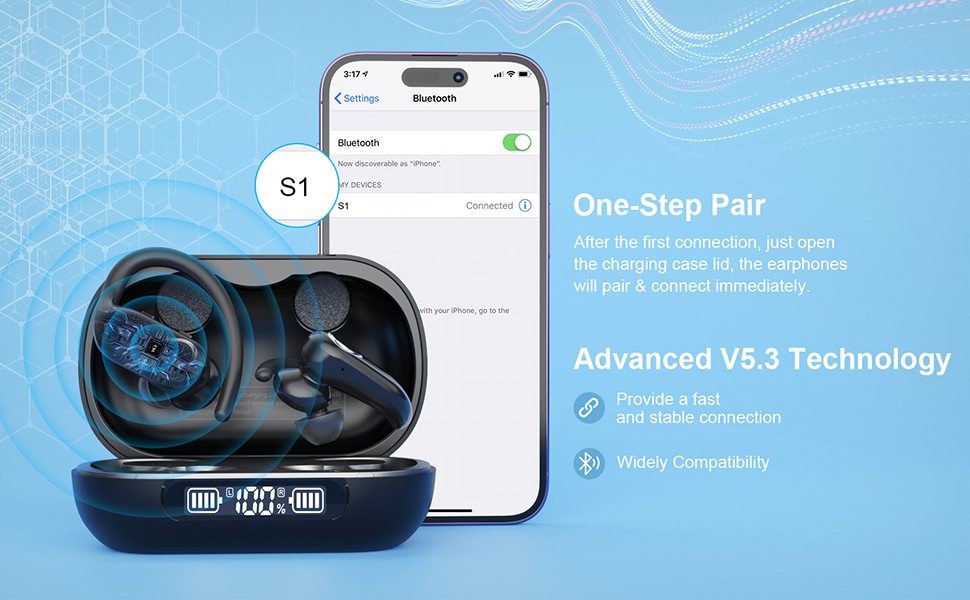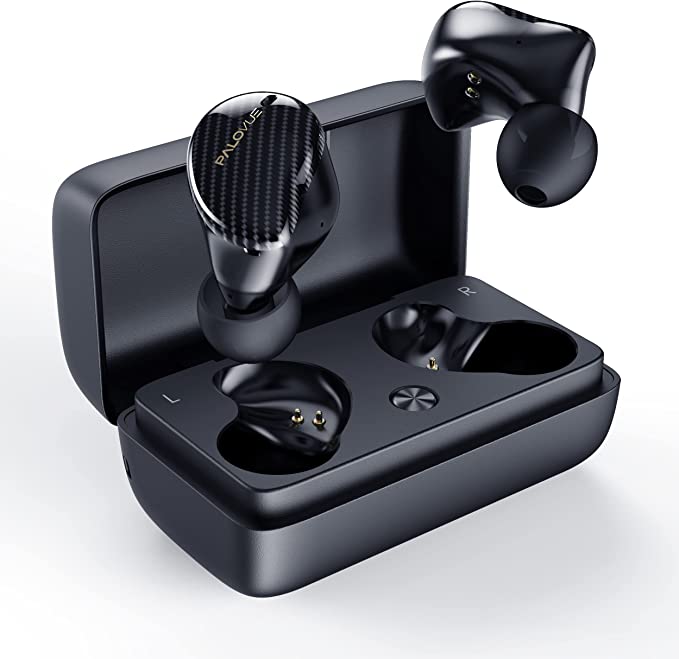PocBuds K6 Wireless Earbuds – The Perfect Companion for Your Music Journey
Update on July 25, 2025, 8:33 a.m.
In the bustling rhythm of modern life, wireless earbuds have become indispensable companions, transforming our commutes, workouts, and quiet moments into personal soundscapes. They are more than just accessories; they are miniature marvels of engineering, seamlessly blending cutting-edge technology with everyday convenience. Yet, beyond the sleek designs and marketing claims, lies a fascinating world of scientific principles that make these tiny devices perform their grand feats. The PocBuds K6 Bluetooth Headphones, a compelling entry in the accessible audio market, offer an excellent opportunity to explore the intricate science that empowers our ears, from marathon battery life to immersive sound and robust durability.

The Unseen Connections: Bluetooth’s Evolution to 5.0
The journey from bulky, wired headphones to the sleek, truly wireless earbuds we cherish today is a testament to the relentless pursuit of audio freedom. A pivotal moment in this evolution arrived with the advent of Bluetooth technology in the late 1990s. Named after a 10th-century Viking king, Harald Bluetooth Gormsson, known for uniting disparate Scandinavian tribes, this wireless standard aimed to unite electronic devices. It operates by creating a personal area network (PAN) using short-range radio waves, allowing data, including high-fidelity audio, to flow seamlessly between your device and your earbuds without the tangles of physical cables.
Bluetooth has steadily evolved through numerous iterations, each bringing significant enhancements in speed, range, and, crucially, power efficiency. The PocBuds K6 leverage Bluetooth 5.0, a widely adopted and robust version of this wireless protocol. This particular iteration offers several key advantages over its predecessors. Firstly, it boasts double the data transfer speed compared to Bluetooth 4.2, which means audio signals can be transmitted with greater fidelity and less compression, preserving the nuances of your music. Secondly, Bluetooth 5.0 significantly extends the wireless range, theoretically capable of reaching up to 240 meters in line-of-sight conditions (though practical use cases like the K6 typically operate within 10 meters, as noted in customer Q\&A, offering ample freedom of movement around your device). Most critically for compact, battery-powered devices, Bluetooth 5.0 is designed for improved power efficiency. It enables devices to communicate while drawing minimal current, directly contributing to the K6’s impressive longevity. This means faster pairing, fewer dropouts, and a more stable, reliable connection for your audio enjoyment.

Endurance Engineering: The Marathon Power of K6
One of the most frequent concerns for wireless earbud users is battery life. The PocBuds K6 directly addresses this with a remarkable claim of up to 50 hours of total playtime when combined with its charging case. Individually, each earbud delivers approximately 5 hours of listening time on a single charge at full volume. This extended endurance is a carefully engineered synergy between advanced lithium-ion battery technology and the inherent power efficiency of Bluetooth 5.0.
At the core of the K6’s enduring power are specialized lithium-ion batteries. These rechargeable power cells are favored in modern portable electronics due to their high energy density, meaning they can store a substantial amount of electrical energy within a relatively small and lightweight package. The fundamental principle involves the movement of lithium ions between a positive electrode (cathode) and a negative electrode (anode) during charging and discharging. The efficiency of these electrochemical reactions ensures maximum energy storage and release, minimizing energy waste. The compact charging case houses a larger lithium-ion battery, acting as a portable power bank that can recharge the earbuds multiple times, extending their usability far beyond a single session.
Further complementing this is Bluetooth 5.0’s sophisticated power management. Unlike older Bluetooth versions that might maintain a constant high-power connection, Bluetooth 5.0 includes features that allow devices to remain connected while consuming minimal power, especially during periods of inactivity or low data transfer. This optimized power profile significantly extends the standby time and overall active use time of the earbuds on a single charge, contributing to the impressive 5-hour individual earbud playtime and, consequently, the 50-hour total with the case.
To empower users with clear information, the PocBuds K6 features a dual LED power display directly on the charging case. This display isn’t just a simple light; it’s a window into a precise Battery Management System (BMS), typically governed by a tiny microcontroller. This integrated circuit constantly monitors the voltage levels of both the charging case’s main battery and the individual batteries within each earbud. This real-time data is then translated into easily digestible formats: a numerical percentage for the case’s charge and intuitive LED bars that visually represent the charging status of each earbud. Each bar illuminating on the earbud indicator typically signifies roughly a 25% charge increment. This transparency eliminates guesswork, allowing you to confidently plan your charging needs and ensure your music never stops unexpectedly. The charging case also supports wireless charging via any Qi-certified mat (not included), relying on the principle of electromagnetic induction to transfer power wirelessly between coils, adding another layer of convenience.
Crafting Sound: The Physics of Immersive Audio
The true essence of any earbud lies in its ability to translate electrical signals into rich, engaging sound. The PocBuds K6 achieve this through their powerful 12mm speaker driver units and a meticulously engineered acoustic design. At the heart of each earbud is a dynamic driver, a miniature loudspeaker responsible for converting electrical audio signals into audible sound waves. This process involves a few key components: a diaphragm (a thin, flexible cone or dome), a voice coil (a coil of wire attached to the diaphragm), and a permanent magnet. When an electrical current representing the audio signal passes through the voice coil, it creates a fluctuating magnetic field. This field interacts with the permanent magnet, causing the voice coil, and subsequently the diaphragm, to vibrate rapidly. These vibrations displace air, creating pressure waves that our ears perceive as sound.
The 12mm size of the drivers in the K6 is significant. Generally, a larger diaphragm can displace a greater volume of air with each vibration, which is particularly effective in reproducing lower frequencies. This translates to a stronger, more impactful bass response, adding depth and fullness to your music that you can not only hear but also feel. While driver size is an important factor, it’s crucial to understand that it’s only one piece of the acoustic puzzle. The quality of the materials used for the diaphragm, the precision of the voice coil winding, and the overall acoustic tuning – the careful adjustment of the driver’s response within the earbud’s housing – are equally vital in achieving the promised clear mids and bright treble, ensuring a balanced and immersive stereo audio experience.
Complementing these drivers is the K6’s unique chamber acoustic design and semi-in-ear structure. This design isn’t just aesthetic; it plays a critical role in sound quality and call clarity. By meticulously balancing the internal and external air pressure within the earbud’s sound chamber, this design works to minimize sound loss and ensure that the audio signal remains stable and penetrating. For communication, this acoustic engineering is particularly beneficial. It helps to isolate your voice from ambient noise, making sure the integrated microphone captures your speech clearly, even in environments with background chatter. This provides a form of passive noise isolation, enhancing the clarity of your voice during phone calls, whether you’re navigating a busy street or in a lively office environment.
Built for Life: Durability, Comfort, and Intuitive Interaction
Modern earbuds are designed not just for listening but for living, integrating seamlessly into our active lifestyles. The PocBuds K6 exemplify this with features built for durability, comfort, and intuitive control.
For those who lead active lives, the IPX7 waterproof rating of the K6 earbuds offers peace of mind. The “IP” stands for Ingress Protection, a standard defined by the International Electrotechnical Commission (IEC) that rates the degree of protection provided by mechanical casings and electrical enclosures against intrusion from foreign bodies and moisture. The “X” in IPX7 indicates that the device has not been formally tested for protection against solids (like dust), but the “7” is crucial: it signifies that the earbuds can withstand temporary immersion in water up to 1 meter (approximately 3 feet) deep for up to 30 minutes. This high level of water resistance is largely thanks to a nano-coated waterproof material applied to the earbuds. This advanced coating creates a hydrophobic (water-repelling) barrier at a molecular level, effectively preventing water from permeating the sensitive internal electronics. This makes the K6 highly resistant to splash damage from sweat during intense workouts or raindrops during an unexpected downpour, ensuring their longevity and reliability in various conditions. It’s a vital distinction, though, that only the earbuds themselves are IPX7 rated, the charging case is not and should be kept dry.
Comfort during extended listening sessions is paramount, and the K6 excels here with its lightweight, ergonomic semi-in-ear design. Each earbud weighs a mere 3.5 grams, making them incredibly light and virtually unnoticeable once seated in the ear. The semi-in-ear form factor is a careful design choice, striking a balance between the secure, isolating fit of traditional in-ear monitors (which seal the ear canal) and the more open, less intrusive feel of earbuds that rest in the outer ear. This design is rooted in human factors engineering, utilizing anthropometric data on average ear canal dimensions and outer ear contours to craft a shape that comfortably and securely cradles within the ear’s concha. This meticulous design minimizes pressure points, ensuring they stay snugly in place during movement without causing discomfort, even over prolonged periods.
Interacting with your audio should be effortless, and the PocBuds K6 achieves this through intuitive smart touch controls, replacing traditional physical buttons. This functionality relies on capacitive touch sensors embedded within each earbud. These sensors detect subtle changes in electrical capacitance that occur when your finger makes contact. When you touch the earbud, your finger acts as a conductor, altering the sensor’s electrical field, which the earbud’s internal circuitry then interprets as a command. This allows for a range of fingertip gestures: a single tap for play/pause, a double tap on the right for volume up and on the left for volume down, a triple tap on the right for next track, and a triple tap on the left to activate your device’s voice assistant. For calls, a simple tap answers, a quick double-click ends the call, and a long press rejects it. This touch-based interface significantly reduces the physical pressure on your ears that traditional click-buttons might cause, enhancing overall comfort.
Furthermore, the one-step pairing feature is enabled by a built-in Hall switch. This magnetic sensor detects when the charging case lid is opened. When the lid lifts, the Hall switch signals the earbuds to automatically power on and initiate pairing with the last connected device, assuming the initial pairing has been completed. This clever application of magnetism streamlines the connection process, ensuring your music starts playing almost instantaneously as you prepare to listen.
The Future Soundscape: What’s Beyond the K6
The PocBuds K6 represents a current benchmark in accessible wireless audio, yet the landscape of sound technology is perpetually evolving. Looking ahead, several exciting advancements promise to redefine our listening experiences further.
While the K6 offers effective passive noise isolation, future iterations, even at competitive price points, may incorporate more sophisticated Active Noise Cancellation (ANC). ANC systems employ microphones to detect ambient noise and then generate an anti-phase sound wave to effectively “cancel out” the unwanted noise, creating a truly silent backdrop for your audio. Another captivating development is Spatial Audio, a technology that creates a three-dimensional soundstage, making music, movies, and games feel incredibly immersive by positioning sounds around you, rather than just from left and right.
The integration of Artificial Intelligence (AI) is also poised to play a larger role. Future earbuds could leverage AI to automatically adapt audio settings based on environmental conditions, analyze user preferences for personalized sound profiles, or even provide real-time language translation. Furthermore, the convergence of health and technology might see earbuds incorporating biometric sensors capable of tracking heart rate, body temperature, and other vital health data, transforming them into discreet wearable health and fitness monitoring devices. Ongoing advancements in Bluetooth codecs – the algorithms that compress and decompress audio data for transmission – will continue to push the boundaries of wireless audio fidelity, aiming for increasingly lossless sound quality over wireless connections.
Beyond the technical marvels, the audio industry is also increasingly embracing sustainability. Consumers are more aware of the environmental impact of electronics. Future products will likely prioritize the use of recycled materials in their construction, adopt more energy-efficient manufacturing processes, and be designed for modularity and longer product lifecycles to minimize electronic waste. This commitment to environmental responsibility will become a significant differentiator, contributing to a more sustainable future for consumer technology.
Conclusion: A Fusion of Science and Everyday Utility
The PocBuds K6 Bluetooth Headphones stand as a compelling example of how advanced engineering principles can be distilled into an accessible, high-performing consumer device. They are a testament to the continuous evolution of wireless audio technology, offering an immersive and reliable listening experience without the constraints of wires or a prohibitive price tag.
Through the lens of the K6, we’ve explored the intricate science behind its features: from the energy-dense lithium-ion batteries and the power-efficient Bluetooth 5.0 that enable its marathon 50-hour playtime, to the physics of its 12mm dynamic drivers and unique acoustic design that craft its rich sound. We’ve also delved into the engineering of its IPX7 waterproofing for rugged durability, the human factors engineering behind its lightweight and ergonomic comfort, and the precise operation of its smart touch controls and Hall switch for seamless interaction.
The PocBuds K6 excels in delivering on the most critical aspects for everyday use: extended battery life, robust sound quality, comfortable fit, and durable performance. They prove that you don’t need to spend a fortune to enjoy the freedom and convenience of truly wireless sound. As we look to the future, the K6 reminds us that the pursuit of superior audio and user experience is an ongoing scientific journey, continually pushing the boundaries of what these miniature marvels can achieve. They are a worthy addition to the ever-evolving landscape of personal audio, offering a harmonious blend of scientific ingenuity and practical utility for the modern listener.



























































